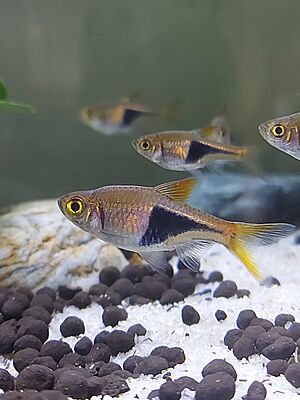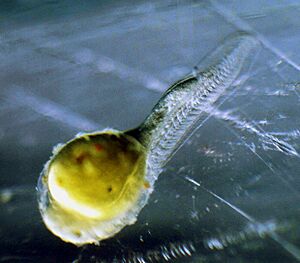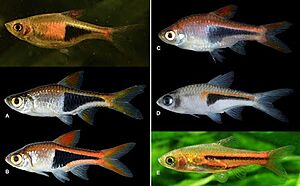Harlequin rasbora facts for kids
Quick facts for kids Harlequin rasbora |
|
|---|---|
 |
|
| Conservation status | |
| Scientific classification | |
| Genus: |
Trigonostigma
|
| Species: |
heteromorpha
|
| Synonyms | |
|
|
The harlequin rasbora (Trigonostigma heteromorpha) is a small, colorful fish that belongs to the Cyprinidae family. This fish quickly became a favorite among people who keep aquariums after it was first introduced in the early 1900s. It is the most well-known and popular type of rasbora fish. In 1935, a picture of three harlequin rasboras was even featured on the cover of a famous book called Exotic Aquarium Fishes by William T. Innes. This picture stayed on the cover for all 19 editions of the book!
Contents
Fish Names and History
This fish was first placed in the Rasbora group. Its scientific name, heteromorpha, comes from Greek words meaning "differently shaped." This name was chosen because its body shape was different from other fish in the Rasbora group.
The common name, harlequin rasbora, comes from the black triangle on its body. This shape looks a bit like the colorful patterns you might see on a harlequin's costume.
What Harlequin Rasboras Look Like
The harlequin rasbora has a body shape that looks a bit like a diamond. Its main color, from its head to its tail, is an orange-pink. The exact shade can change depending on the water conditions and where the fish originally came from.
The back half of its body has a large, black mark that looks like a triangle. This black mark gets thinner towards the tail and starts around the middle of its top fin. People often call this mark a "black wedge."
Like all fish in the carp family (cyprinids), its fins are placed in a common way. The fins near its head (pectoral fins) are right behind its gill covers. The fins on its belly (pelvic fins) are further back, almost directly below its top fin. This fin arrangement is also seen in other fish groups, like characins. It's a special feature of fish that have tiny bones called Weberian ossicles which help them hear.
The fins on its back, belly, and tail are all tinted red. The tail fin is forked, and the red color is strongest on the outer parts of the fin, while the middle part is clearer.
It can be easy to mix up the harlequin rasbora with two similar fish: Trigonostigma espei and Trigonostigma hengeli. These two fish used to be thought of as types of harlequin rasboras. However, they are thinner than the harlequin rasbora. Also, their black mark is not a clear triangle. Instead, it's a horizontal stripe that gets wider and points downwards below the top fin. Because of this shape, these fish are sometimes called "lamb chop rasboras."
A full-grown harlequin rasbora usually reaches about 4 to 4.5 centimeters (about 1.5 to 1.7 inches) long. The biggest they can get is about 5 centimeters (2 inches).
Males are said to have a slightly larger black patch on their bodies than females. The part of the black patch near the belly fin is more rounded in males. Females that are ready to lay eggs look noticeably rounder and fuller.
Where They Live and Their Home
The harlequin rasbora is originally from Malaysia, Singapore, Sumatra, and Borneo. However, the fish found in southern Thailand are now known to be a different species, Trigonostigma truncata, which was described in 2020.
These fish live in streams and other waterways. These waters usually have very few minerals and a lot of dissolved humic acids. This happens because the water flows through peat swamp forests. In these forests, fallen leaves don't fully break down, which creates peat. This peat then releases humic acids into the water. The water conditions are similar to the "blackwater" habitats found in South America, like the Rio Negro.
Taking Care of Harlequin Rasboras in an Aquarium
Even though harlequin rasboras live in waters with similar chemistry in nature, they can adapt well to different conditions in an aquarium. It's important to introduce them to new water slowly and carefully. They can live in water with a pH from 6.0 to 7.8 and hardness from zero to 15°dH. For just keeping them healthy, the water chemistry isn't super strict as long as the tank is kept clean. However, for breeding, the water chemistry becomes much more important (see below).
The best temperature range for harlequin rasboras is usually 22°C to 27°C (72°F to 81°F). But they can live in temperatures from 21°C to 28°C. They usually breed at around 28°C (82.4°F).
Harlequin rasboras are schooling fish, which means they like to swim together in groups. You should keep at least six of them together, but a larger group is even better. This is not only good for the fish's well-being but also looks amazing! A big group of harlequin rasboras swimming actively is a beautiful sight. They are peaceful fish, so you can keep them with other small, calm aquarium fish. This includes many small characins from South America, small barbs, danios, other small rasboras, Corydoras catfishes, and Otocinclus catfishes.
An aquarium for harlequin rasboras should have live plants. Make sure there are also some open areas for them to swim. Plants like Cryptocoryne species are good choices because they grow in the harlequin rasbora's natural home. Some Asian Aponogeton plants can also be used. Bushy plants like Cabomba can be used too, but they need bright light. Cryptocoryne and Aponogeton prefer dimmer light, just like the harlequin rasbora. So, if you want different plants, choose ones that like similar lighting. The filter should create gentle currents, as their natural homes usually have slow-moving water. However, the filter still needs to be strong enough to keep the aquarium clean.
Feeding harlequin rasboras is easy because they happily eat prepared fish foods. For the best health, you should give them a variety of foods. It's also good to give them live foods like Daphnia sometimes. If you want them to breed, feeding them live foods will greatly increase your chances of success. Mosquito larvae are also excellent conditioning food for them.
The exact lifespan of a harlequin rasbora isn't fully known. But with good care in an aquarium, they can live for five to eight years.
Reproduction and Life Cycle
Harlequin rasboras breed differently from many other popular rasboras. Most rasboras scatter their eggs freely. But harlequin rasboras stick their eggs to the underside of plant leaves, like Cryptocoryne and Aponogeton.
When it's time to breed, the female will swim upside down under a chosen leaf. She rubs her belly along the leaf to get ready. This action seems to encourage the male to join her. When the male joins, he also swims upside down next to her. As the female lays her eggs and sticks them to the leaf, the male curls his tail around her body and fertilizes the eggs. They lay about six to 12 eggs at a time with each embrace. They repeat this process for two hours or more. A large, well-fed female might lay as many as 300 eggs, but 80 to 100 is more common.
For breeding, the aquarium needs to have suitable plants, with Cryptocoryne species being the top choice. The water in the breeding tank must be soft and acidic. These fish are unlikely to breed in hard, alkaline water. Also, the eggs might not develop well in such conditions, even if the parents do lay them. Some aquarists like to filter the water over peat. This helps create the humic acid levels found in the fish's natural habitat. However, this isn't strictly necessary if the basic water conditions are right (no harder than 4°dH and a pH around 6.4). The breeding temperature should be 28°C (82.4°F). Before trying to breed them, feed the parent fish a lot of live foods like Daphnia and mosquito larvae. Once the fish have finished laying eggs, you should remove the parent fish from the breeding tank. This is because they might eat their own eggs.
You can find a great black-and-white photo in William T. Innes' book Exotic Aquarium Fishes on page 171. It shows the female swimming upside down as she gets ready to lay eggs.
How Young Fish Grow
Harlequin rasbora eggs usually hatch in about 18 hours if the temperature is 28°C. When they hatch, the baby fish (called fry) are clear and about three to four millimeters long. They stay attached to the leaf where the eggs were laid for another 12 to 24 hours. During this time, they absorb the yolk sac, which gives them food.
Once the yolk sac is gone, the fry start swimming freely. At this stage, they need very tiny food, like live infusoria, for about seven to 14 days. After that, the fry are big enough to eat newly hatched brine shrimp. If you can't find infusoria, you can also use special prepared foods made for baby egg-laying fish.
It takes about eight to ten weeks for the harlequin rasbora fry to get their full adult colors.
Trigonostigma truncata (Tan, 2020)
Trigonostigma truncata is a new species of harlequin rasbora that was discovered in 2020. It lives in the swamp forests along the east coast of the Malay Peninsula.
This new species is different from other similar fish in a few ways. It has a gently sloping head and neck. Its special black triangular mark, called an "axine," is large, but its tip doesn't reach the base of the tail fin. It also has an orange-red color on its anal fin (the fin on its belly near the tail). When it's alive, its body has a bluish-lilac shine. Compared to the harlequin rasbora (T. heteromorpha), Trigonostigma truncata has a shallower body.
See also
- List of freshwater aquarium fish species





